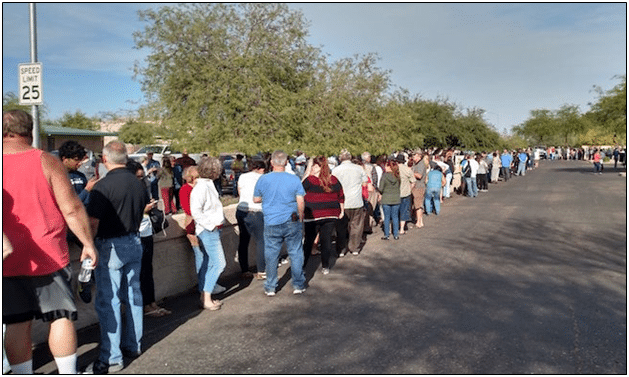
The Democratic Party has been searching for its edge ever since President Donald Trump won reelection in November. Demographic destiny — the idea that Hispanics and young voters would merge into eventual Democratic voters and propel the party forward — has not panned out as both groups are moving toward the right over time.
Reeling in moderate voters has failed as well, as moderate voters are largely repelled by the Democratic Party’s fixation on fringe social issues over substantive issues like the border and the economy.
Focusing on turnout or increasing the number of voters who participate in elections has not favored Democrats in recent years either. In fact, increased turnout among low-propensity voters has been a thorn in the party’s side in recent elections.
In 2024, over 155 million people cast ballots in the presidential election, making it the second highest number of participants in U.S. history, with 2020 representing the highest, and even then, it netted former President Joe Biden the weakest legislative majorities for a Democratic president since Grover Cleveland. Turnout was 63.9 percent of eligible voters, the second highest in history, with 2020 being slightly higher.
High turnout among low propensity voters delivered President Trump the electoral college and the popular vote for the first time for a Republican in two decades, meaning turnout is now no longer in the Democrats’ toolbox either.
What is left? According to some political analysts the main weapon Democrats have in the modern era is to appeal to and engage the most high-turnout voters in the party and focus on off-year and special elections.
Nate Cohn at the New York Times speculated this week that Democrats would perform well in Tuesday’s special election in Florida due to highly active voters being concentrated in the special election voter pool.
Democrats have a streak of doing well in elections when only the most active voters turn out, as Cohn pointed out. “Throughout the Trump era, Democrats have excelled in low-turnout elections, as the party appears to fare best among the most highly engaged, regular voters”, Cohn noted.
Looking at the results of Tuesday’s special election in Florida, Democrats did perform better than expected. Americans for Limited Government Foundation Executive Director Robert Romano noted Wednesday that while Republicans held onto their seats in both the 1st and 6th congressional districts, their Democratic challengers overperformed by about 8 to 9 points in each district.
So, what does the Democratic Party’s recognition that it performs best in elections where only the most highly engaged voters participate mean for the future? Understanding the position in which the Democratic Party finds itself is important for conservatives, so that we do not find ourselves blindsided. There are a few strategies that the party could utilize based on its current position.
First, Democrat leadership may reject calls from the center of the party to adopt a more moderate set of principles and appeal to low propensity voters. The party’s edge in the modern era is with the most highly active — and liberal — voters, so appealing to the center could be seen as a poor trade off.
Second, Democrats may focus more on off-year elections. They may strategize to focus heavily on amassing more Congressional power through mid-term elections and using that power to mitigate a Republican president elected by a larger sample of the people.
Last, Democrats may in fact seek to lower or “depress” voter turnout especially among low-propensity voters, poorer white voters, young people, and Hispanics. Where once the idea of activating working-class whites, young voters and Hispanics seemed like a surefire way to increase their numbers at the ballot box, Democrats may realize that they could end up drumming up just as many votes from Republicans as they do for themselves through increasing turnout.
We are already seeing discussions of the way turnout used to benefit Democrats, but no longer does, among mainstream political analysts.
Miles Parks, an NPR correspondent who studies elections, noted in an NPR interview after the 2024 election that “less educated” and “poorer people generally”, historically favored Democrats when they did vote, but this is no longer true.
“Research has found that these sorts of people are generally less educated, are poorer people generally, and those sorts of people have tended to vote for Democratic candidates,” Parks noted. “Therefore, higher turnout brings out more of these sorts of people, helps Democrats.”
Parks went on to speak about Trump’s edge with low propensity voters upsetting this narrative. “But Trump seems to have really changed the game here. Exit polls found that he did really well among people without a college degree and also won people who said it was the first time they’d ever cast a ballot. So the question now is whether this is going to change how Republicans feel about voter turnout and also, critically, policies that make voting easier, since those policies have been shown to help low-propensity voters the most.”
Perhaps Democratic Party leaders will not outright suppress the vote — though anything is possible — but they may focus on launching more attack campaigns at conservatives to turn off low propensity, minority, and young voters more than they focus on activating these voters.
Democrats might also recruit less frequently among working-class whites, Hispanics, and young people, and attempt to predict who will become a high propensity voter instead by using benchmarks like education and income.
Conversely, conservatives may continue to widen their tent, making inroads with larger portions of the low-propensity vote, capitalizing on their edge during highly publicized election years, and developing defensive strategies to boost their own turnout during off-year elections.
Manzanita Miller is the senior political analyst at Americans for Limited Government Foundation.






